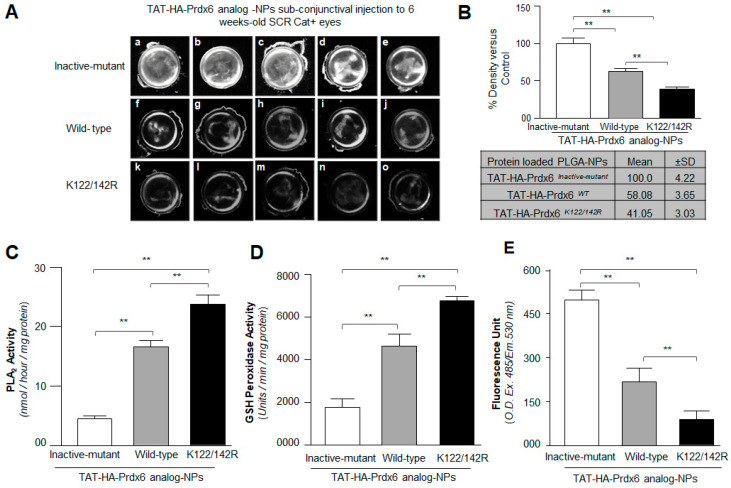Figure 6.
(A,B) Preventive effect of TAT-HA-Prdx6WT-NPs and Sumoylation-deficient Prdx6-NPs in the eye on progression of cataract in SCR rats. Six-week-old SCRs were administered subconjuctivally with either TAT-HA-Prdx6WT-NPs or Sumoylation-deficient TAT-HA-Prdx6K122/142R-NPs (right eye: 25 µg/10 µL in physiological saline) and TAT-HA-Prdx6Inactive-mutant-NPs (left eye; 25 µg/10 µL in physiological saline). At the end of the experiment, lenses were removed and photographed using a stereomicroscope; (A) Representative photographs showing the opacity of lenses treated with TAT-HA-Prdx6-analog-loaded NPs, as shown. (B) The relative density of lenses was measured, and values were presented as histograms. (C,D) Sumoylation-deficient TAT-HA-Prdx6K122/142R-NPs had increased aiPLA2 and GSH peroxidase activities compared to TAT-HA-Prdx6WT-NPs. Total protein was isolated from the lenses, and assays were performed for (C) aiPLA2 and (D) GSH peroxidase activities. Histogram values represent the mean ± SD from three independent experiments. TAT-HA-Prdx6Inactive-mutant-NPs vs. TAT-HA-Prdx6WT-NPs and TAT-HA-Prdx6K122/142R-NPs; TAT-HA-Prdx6WT-NPs vs. TAT-HA-Prdx6K122/142R-NPs (** p < 0.001). (E) Reduced ROS generation was observed in Sumoylation-deficient Prdx6 NPs in comparison with Prdx6 WT-NPs. Six-week-old SCRs were administered subconjuctivally with either TAT-HA-Prdx6WT–NPs or Sumoylation-deficient TAT-HA-Prdx6K122/142R-NPs (right eye: 25 µg/10 µL in physiological saline) and TAT-HA-Prdx6Inactive-mutant–NPs (left eye; 25 µg/10 µL in physiological saline). At the end of the experiment, lenses were removed, and homogenates were prepared. ROS levels were monitored with H2-DCF-DA dye assay. Data represent means ± S.D. of three independent experiments. ** p < 0.001.

